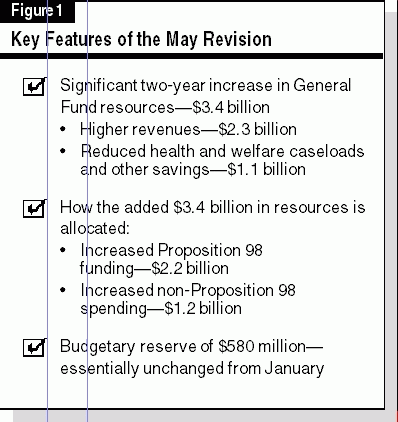

Figure 1 highlights the major features of the May Revision, which was released on May 14.

It shows that higher revenues, lower health and welfare caseloads, and other savings have combined to produce $3.4 billion in added budgetary resources since January. Specifically, revenues are up $2.3 billion over 1996-97 and 1997-98 combined, reflecting strong economic growth and higher-than-expected cash receipts in recent months. At the same time, caseload reductions in health and welfare programs, reduced debt-related expenses, and a number of smaller program savings, have combined to lower General Fund spending by about $1.1 billion in the current and budget years combined.
Where Would the Money Go? Figure 1 also shows that $2.2 billion of these new resources would go for K-14 spending, consistent with the Proposition 98 minimum funding guarantee, and $1.2 billion would go toward increased spending on non-Proposition 98 programs. The revised spending plan includes significant new K-12 education funding for class size reduction and other initiatives, as well as new spending for welfare reform-related child care and local fiscal relief.
Because virtually all of the new resources are utilized for program spending, the revised budget proposal reflects only a slight net change to the 1997-98 year-end reserve. The revised budget plan would result in a reserve of $580 million, up $27 million from the January proposal.
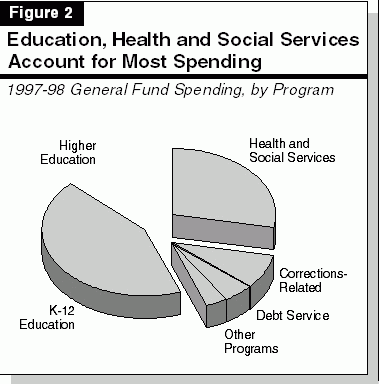
Since January, the "dollar size" of the expenditure pie has gotten bigger by $2.3 billion. In addition, the K-12 education share has gotten a bit bigger relative to the other pieces of the pie, due to the increased Proposition 98 funding.
Aside from the major changes in Proposition 98 funding, the May Revision retains most of the same priorities as the Governor's January budget. Specifically, it includes the Governor's corporate tax rate reduction proposal, his welfare reform plan, his proposals to make permanent certain welfare grant reductions, significant increases for higher education, full funding for the Department of Corrections, and no renters' credit.
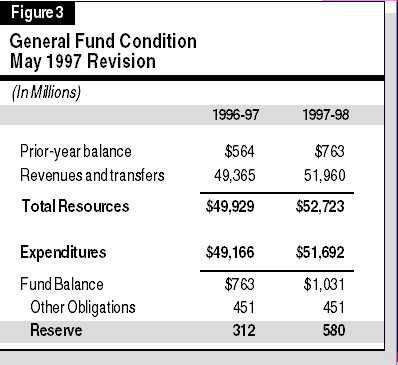
Revenues and Expenditures—Moderate Overall Growth. Revenues are projected to be $49.4 billion in 1996-97 and $52.0 billion in 1997-98, reflecting growth of 6.6 percent and 5.3 percent, respectively. Expenditures are projected to reach $49.2 billion in 1996-97 and $51.7 billion in 1997-98, reflecting growth of 8.0 percent and 5.1 percent. Budget-year expenditure growth ($2.5 billion) is roughly in line with budget-year revenue growth ($2.6 billion).
Modest Budget Surplus—Little Change. As Figure 3 indicates, the May Revision projects a 1997-98 year-end budgetary reserve of $580 million. This is up slightly—by $27 million—from the January budget projection, and is equivalent to about 1.1 percent of General Fund expenditures. On a cautionary note, such a reserve would provide the state with protection against relatively modest fiscal problems, but not more significant ones such as a material slowdown in the pace of economic growth. The projected reserve, however, is of better "quality" than January's due to more realistic budgetary assumptions.
The Economic Outlook—Revised Up. Reflecting current trends, the administration's economic forecast has been revised up from January. As shown in Figure 4, for example, projected employment levels and job growth have increased. The department's new economic forecast is similar to our own.
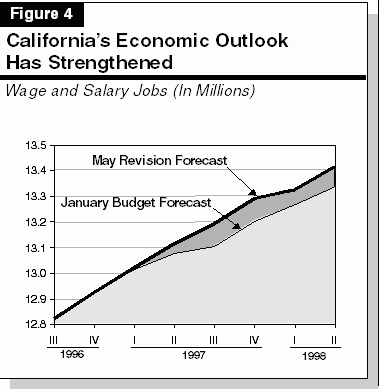
Revisions Are Reasonable. The new revenue figures generally are consistent with current economic and revenue collection trends, and in this context appear reasonable. Prior to the May Revision, we reported preliminarily that two-year revenues would be up by roughly $2 billion but that we would "fine tune" our estimates later in the month, once certain data became available. Having had a chance to do this, our revised revenue projections indicate increased revenues of $2.5 billion — or about $250 million more than the Governor's May Revision. While this difference is significant in dollar terms, it is relatively small given the magnitude of total revenues (over $50 billion annually).
It is unusual for the minimum guarantee under Proposition 98 to "use up" such a large percentage of new General Fund revenues — the May Revision estimates that Proposition 98 would use virtually 100 percent of the new tax receipts. This large increase is due to three changes that have occurred since the Governor's Budget was issued in January:
Higher Revenues. The higher General Fund revenues trigger an increase in Proposition 98 funding. Our calculations show that $986 million of the new Proposition 98 funds (about 45 percent of the May Revision General Fund increase) results from the higher tax receipts.
State Population. The Department of Finance reduced its 1996 estimate of the state's population. This change, which also affects subsequent years, acts to increase the Proposition 98 minimum guarantee. Our estimates show that the population revision accounts for $576 million of the new Proposition 98 funds.
School Attendance. Preliminary reports of 1996-97 school attendance are up sharply from the January estimate. The revised attendance figures require an additional $443 million in Proposition 98 funds.
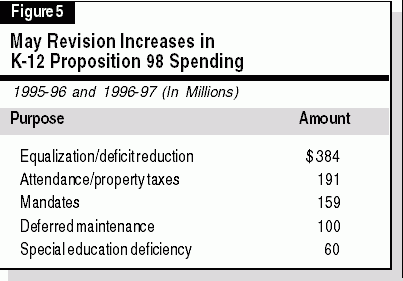
1997-98 Funds. Figure 6 displays the major May Revision increases in K-12 funding for 1997-98. The budget proposes $411 million to continue the revenue limit increases proposed with prior-year funds in the budget year. The May Revision also proposes to increase funding for a variety of other initiatives, including $230 million for higher per-pupil funding for class size reduction ($800 per pupil), a $64 million increase in the subsidized child care programs operated by the state Department of Education, and $59 million for a new statewide pupil testing program.
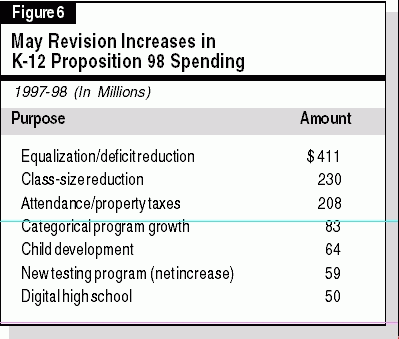
1997-98 Funds. The May Revision includes a $109 million increase for community colleges. The largest budget-year increases are proposed for instructional equipment ($29 million), offsetting lower estimated property taxes ($26 million), and enrollment growth ($18 million).
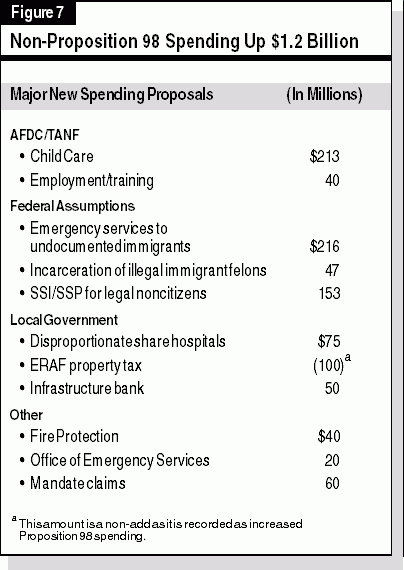
More Realistic Budgetary Assumptions. The budget provides a $216 million set-aside in the event that the federal government does not provide funding for emergency services for undocumented immigrants. It also increases state funding by $47 million to reflect more realistic assumptions regarding federal reimbursements for the incarceration of illegal immigrant felons. These two factors reduce the General Fund's dependence on uncertain federal actions from $636 million in January to $373 million, the lowest in many years. Also included are $60 million for local mandate claims (in addition to those funded by Proposition 98), $40 million for additional fire suppression costs, and $20 million for disaster relief.
We note that average costs per eligible person tend to rise in times of falling caseloads because persons who remain on the caseload tend to require relatively more care. The increases projected in the May Revision, however, appear to be larger than can be explained by this effect and anticipated inflation.
2. Temporary Assistance for Needy Families (TANF)
Caseloads. The May Revision estimates that AFDC/TANF caseloads will decline by 5.9 percent
in 1996-97 and 10.1 percent in 1997-98. This would result in General Fund savings of about
$800 million over the two-year period, compared to the January budget estimate. The May
Revision projection represents a significant acceleration in the declining trend in the caseload
since 1994-95 (see Figure 8).
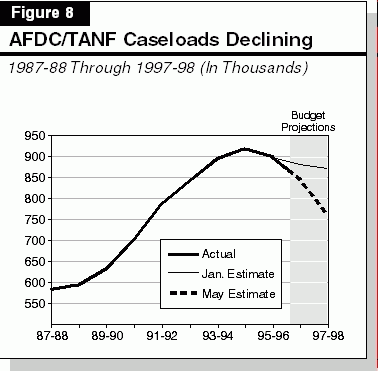
Based on our estimates, caseloads are projected to decline by 6 percent in the current year and 5.4 percent in the budget year. This would result in General Fund savings of about $200 million less than the amount of savings estimated in the May Revision.
We note that there is considerable uncertainty in projecting AFDC/TANF caseloads. The May Revision estimate assumes continuation of the downward trend experienced over the last six months. While this estimate may not be unreasonable, it entails more risk than our projection. This is because it appears to rely heavily on a trend established over a relatively short period of time.
CalTAP. The May Revision proposes budget adjustments and an expansion of the Governor's welfare reform proposal (CalTAP). The major change consists of $213 million in federal TANF block grant funds that would be allocated to the State Department of Education and then transferred to the Department of Social Services (DSS) to provide child care for CalTAP recipients. This includes $95 million to (1) correct a technical error in the January budget proposal, (2) adjust for an upward revision in the estimated costs, and (3) provide for additional child care due to a proposed change in the date of implementation of the services component of CalTAP for new applicants (from April to January 1998). Based on our preliminary review, however, the remaining $118 million would not be needed to fund the direct child care requirements of CalTAP. The administration has not provided the Legislature with an expenditure plan for these funds. However, they could be used for CalTap-related activities (for example, training new providers of child care).
3. SSI/SSP
Noncitizens. The January budget assumed General Fund savings of $153 million due to
elimination of SSI/SSP eligibility for legal noncitizens, pursuant to federal welfare reform
legislation. Subsequently, Congressional leaders and the federal administration have agreed, in
budget negotiations, to continue eligibility for disabled noncitizens who were in the country
prior to August 22, 1996. The May Revision restores these funds, as well as a related $24
million in the In-Home Supportive Services program, on the assumption that the final federal
budget agreement will restore eligibility.
The May Revision also proposes to provide $75 million to certain counties under the Disproportionate Share Hospital Program and $50 million to capitalize the California Infrastructure Bank.
Considerations for the Legislature. While the $100 million property tax return will be available to local entities for general purposes, the $75 million for the Disproportionate Share Hospital Program and the $50 million to capitalize the California Infrastructure Bank are tied to specific programs. In addition, the May Revise includes $100 million to continue the COPS program (also a targeted program) as proposed in January. The Legislature might want to consider combining funding from these and other proposals in order to provide a larger amount of discretionary resources to local governments.
For questions regarding this report, call Brad Williams at (916) 324-4942.| The Legislative Analyst's Office (LAO) is
a nonpartisan office which provides fiscal and policy information and advice to the Legislature. LAO Publications |